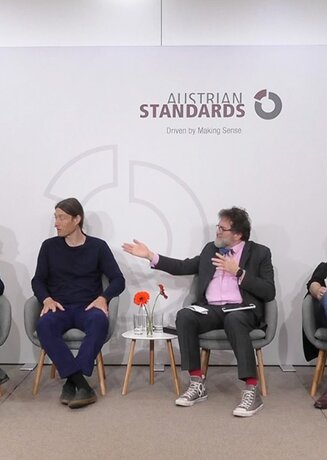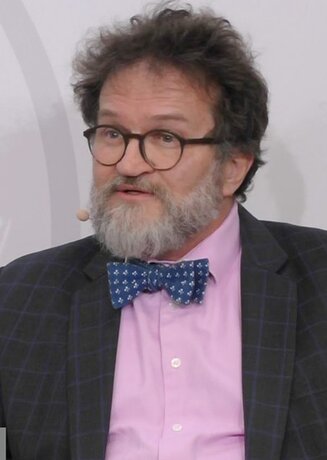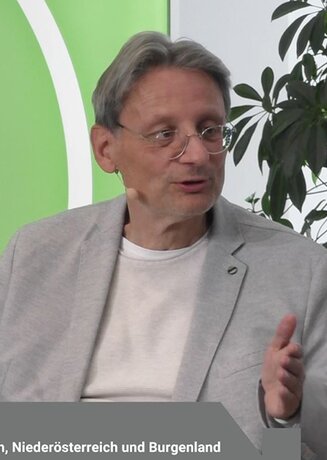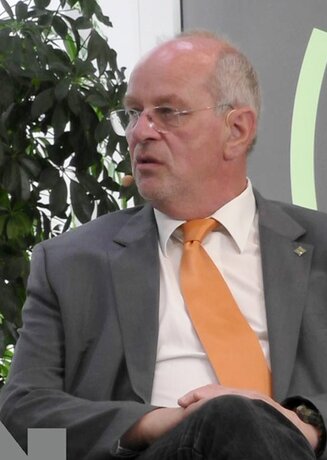3nd construction industry meeting
The 3rd virtual construction industry 'Baustammtisch' meeting took place on 4 May with the title of "Demolition or renovation – what is really more sustainable?". The event was held by Austrian Standards together with the media partner ImmoFokus and the Chamber of Civil Engineers for Vienna, Lower Austria and Burgenland.
Peter Bauer, Deputy Chair of the Engineer Consultants Department of the Chamber of Civil Engineers for Vienna, Lower Austria and Burgenland, Georg HofmannDigitalisation & Regulatory Expert, DoTank Circular City, City of Vienna, Armin Knotzer, Project Head at AEE INTEC, Board Member RENOWAVE.AT, Thomas Pipp, Policy Officer at Austrian Federal Railways (ÖBB), and Franz Schwendemann, Team Leader OFM Building Data & Conditions, Bundesimmobiliengesellschaft m.b.H were on the podium this time.
The round table, moderated by ImmoFokus editor-in-chief Michael Neubauer, also considered the question of what framework conditions are required so that we can afford sustainable renovation. The construction industry 'Baustammtisch' meeting takes place regularly as part of the Dialogforum Bau Österreich.
The circular economy is a key element of the climate-friendly consumption of resources in the construction sector. Durability and recyclability should now already be being taken into consideration in the planning phase for new buildings. Waste generation can also be reduced with closed construction material cycles. Five experts considered issues including the question as to how existing building stock which was not planned and built according to the circular economy is to be dealt with.
Demolition as a last resort
The panel was immediately united that when it comes to sustainable planning, building and renovation, it's not black and white, wrong and right. We have to operate in the grey areas. However, there is also agreement that demolition should be the last resort.
Peter Bauer: "Between renovation, dismantling or demolition, there are a whole load of grey areas, for example adapting areas in every shade from bland to radical. From my point of view, conversion is very important and I believe that the field of sustainability is very spread out across this entire spectrum." In direct comparison, renovation is generally more sustainable than demolition."
Franz Schwendemann reported from practical experience: "Every day we are faced with the dilemma as to whether to opt for renovation or demolition. Three factors are to be considered in this process. If a building has high cultural or historical value, it will not be demolished. However, renovation also relies on having a robust and stable building structure. An extremely important factor is also the option of converting the building. I think those of us on the podium are of the same opinion that, after renovation, conversion or at the very least dismantling should be the aim, and demolition should only be the last resort if there is no other option. However, that is also a question of true-cost pricing."
Every building is a source of raw materials
For Peter Bauer, existing buildings are valuable sources of raw materials: "We should no long view old buildings as something annoying. A lot of CO2 has already been emitted to build them, so it hurts to see reinforced concrete buildings still simply being torn down. For example, Wilhelminian-era buildings are fantastic structures, but their thermal insulation is not ideal. There are not just two solutions – 0 or 100 – here. We also have to make use of the grey zones with regard to cosiness. If a building has been inhabited for a hundred years, does it really suddenly need modern sound insulation?" Traditional timber joints which don't need nails are another step on the path towards the circular economy for builders. "Unfortunately, these types of technologies were abandoned because the artisan tradition was lost. However, today's machinery could do that again, and with unbelievable precision and speed. We could learn a huge amount from history and from traditional techniques."
Georg Hofmann added: "I can only agree. If we renovate, the only question is how we renovate. We need new binding materials instead of adhesives for existing buildings, and sustainable materials in order to get started in the circular economy. Reuse and, at least, the recycling of material, must be the aim of every construction project. This is a huge challenge, which would be easier to tackle if we knew exactly which masses and materials were to be installed where."
Problem of composite materials
Franz Schwendemann is aware that surveying takes a huge amount of effort. An energetic evaluation of all existing buildings is currently under preparation. "It is a definitely a real endeavour, but should be able to take place relatively promptly in order to determine where upgrades are required." He views composite materials in façades and windows as well as in supporting structures as problem areas. In order to meaningfully keep these components in the material cycle, a little thought is required. Schwendemann views a landfill ban for certain construction materials as part of the solution. A tightening in regulations is to be expected in the next few years, which will increase the cost pressure on disposal.
Thomas Pipp shared this opinion and is certain that there will be many more initiatives with a view to the circular economy in the future. Recycling sustainable construction materials and parts and using them as new construction material as a minimum – instead of depositing them or burying them – will create a completely new branch of the construction industry, including the certification of these construction materials.
One method for achieving this is true-cost pricing and a common mindset
However, for Armin Knotzer , many current efforts are simply not well-thought-out enough: "So long as we are not sure in which existing buildings we want to implement which measures, and there are no specific objectives, many initiatives are inefficient at the least. There is a lack of a holistic plan, the overall picture, and I believe there is not the political will." Georg Hofmann ointed out that there is a very wide variety of evaluation matrices and evaluation systems. "That's why it is important to evaluate the actual key figures in a really goal-oriented manner."
Armin Knotzer: "There are sure to be discrepancies, even in the methodology. And I admit you are completely right, but I think that the objectives you have to define are much more important. You will then also find the methods. After all, it is not possible to know why certain specifications and key figures, as in the EU regulation on taxonomy for sustainable activities, were defined in the first place if the overall objective is missing."
Peter Bauer added: "We also need the right instruments in order to achieve the objectives. I am also very hopeful for relevant legislation including true-price costing. In the Austrian Landlord and Tenant Act, all costs in relation to energy are simply passed on to the tenants. However, models which take all costs, including in relation to environmental impact, into account in the life cycle calculation and motivate clients to make long-term calculations are needed. We really need a big overall picture with a few informative key figures that provide us with a guideline. What is required for this is a mindset that sustainability is a task for the whole of society that we have to take care of together."
Renovation means finding compromises
A stumbling block for sustainable renovation or adaptation is always the technical possibilities. Franz Schwendemann: "In an where homes are in short supply, there's a desire to make residential units smaller. However, if a loft conversion or multiple floors cannot be supported by the existing structure for technical reasons, the only option remaining is dismantling or demolition. Densification will probably be a huge topic over the next few decades, particularly in the residential sector." Georg Hofmann added: "This will not only be true in existing cities, but also in areas of urban expansion."
When it comes to the topic of sustainable renovation, it is therefore advisable to make use of the grey areas and seek out all legal options to find the best solution in negotiation with the authorities and partners such as the labour inspectorate, fire brigade, building inspectorate and preservation of sites with historic interest as well as in the interests of tenants. The basis for this approach is to find a compromise which is acceptable for everyone according to Franz Schwendemann. It is not only Schwendemann who views a large number of liability issues arising in these kinds of grey areas as an obstacle, meaning it is all the most important that there is expert advice during each project.
Appreciating tried-and-tested knowledge, but also rethinking what has becoming stale
Finally, one thing is definite for all those involved in the discussion – if we don't rethink things now and invest in sustainable buildings, the next generations will have to pay a high price. The thing that is missing is reliable data about existing buildings and the definition of a big overall objective. In order to achieve a circular economy, tried-and-tested technologies as well as innovations are required. Ultimately, we will not only have to rethink key figures and calculation models, but also our requirements.
More on the topics
- Read all about the 2nd virtual construction industry 'Baustammtisch' meeting: Sustainable construction requires know-how and true-cost pricing
- Read all about the 1st virtual construction industry 'Baustammtisch' meeting: En route to the BIM library: ensuring that "BIM" doesn't become a Tower of Babel
More information about the Austrian Construction Dialogue Board (Dialogforum Bau Österreich)









